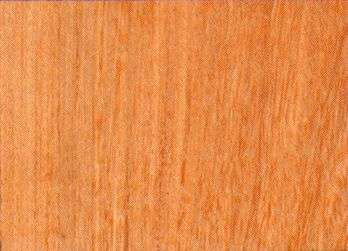
Asainda (Ougenia dalbergioides)
Family: Papilionaceae
Common names: Asainda, Banchan, Bandhona, Banjan, Chichera, Chikkudu, Dargu, Darji, Eru, Jaru, Kala palaj, Kala-phulas, Kalbenga, Kuri-mutal, Naiponai, Panan, Panjan, Pannan, Rot, Ruta, Ruthu, Rutok, Sandan, Sandan pipli, Sannan, Sar, Ser, Shanjan, Shermana, Tanaj, Tella motku, Tellamotku, Telus, Tewas, Tewsa, Timsa, Tinas, Tinnas, Tinsa, Tinsai, Tiwas, Tunnia, Vandanam
Distributed in: India (Oceania and S.E. Asia)
Common uses: Agricultural implements, Boat building (general), Boxes and crates, Cabinetmaking, Cooperages, Furniture, Handles: woodworking tools, Heavy construction, Light construction, Plywood: veneer (marine), Poles, Posts, Shade rollers, Textile equipment, Tool handles, Vehicle parts, Wheels
Tree size: Tree height is 30-40 m
Colors: the heart isYellow, Yellow to golden-yellow to orangeand the sapwoodWhite, Yellow.The grain isMottled figure, the textureMediumand the lusterLustrous
Natural durability: Susceptible to insect attack, Very durable
Kiln Schedules: UK=F US=T6D4/T3D3 Fr=6
Kiln Drying Rate: Slow (18-28 days for boards < 32 mm, to 52-84 days for boards >= 63 mm)
Drying Defects: Moderate surface checking
Ease of Drying: Easy
Tree Identification: Bole/stem form is straight
Comments: General finishing qualities are rated as good General finishing qualities are rated as poor
Blunting Effect: Blunting effect on machining is moderate
Cutting Resistance: Cutting Resistance with green wood is difficult
Resistance to Impregnation: Resistant sapwood
Response to hand tools: Easy to machine
Turning: Good results
Polishing: Satisfactory;
- Numerical data Metric
- Numerical data English
- Strength properties
- References
 |
 |
 |
 |
| Item |
Green |
Dry |
Metric |
| Specific Gravity |
|
|
|
| Density |
|
881 |
kg/m3 |
| Bending Strength |
617 |
961 |
kg/cm2 |
| Crushing Strength |
348 |
530 |
kg/cm2 |
| Hardness |
|
1051 |
kg |
| Impact Strength |
|
114 |
cm |
| Shearing Strength |
|
192 |
kg/cm2 |
| Stiffness |
88 |
103 |
1000 kg/cm2 |
| Tangential Shrinkage |
|
|
% |
| Radial Shrinkage |
4 |
|
% |
| Weight |
865 |
689 |
kg/m3 |
| Maximum Load |
|
|
cm-kg/cm3 |
| Toughness |
|
|
cm-kg |
| Static Bending |
|
|
kg/cm2 |
|
 |  |  |  | | Item | Green | Dry | English | | Bending Strength | 8777 | 13675 | psi | | Density | | 55 | lbs/ft3 | | Hardness | | 2318 | lbs | | Impact Strength | | 45 | inches | | Maximum Crushing Strength | 4963 | 7551 | psi | | Shearing Strength | | 2745 | psi | | Stiffness | 1264 | 1472 | 1000 psi | | Weight | 54 | 43 | lbs/ft3 | | Radial Shrinkage | 4 | | % | | Tangential Shrinkage | 7 | | % | |
Density (dry weight) = 53-60 lbs/cu. ft
Hardness (side grain) = hard
Toughness-Hammer drop (Impact Strength) = medium
Shrinkage, Tangential = moderate
Shrinkage, Radial = moderate
Max. crushing strength = high
Bending strength (MOR) = low
Toughness-Hammer drop (Impact Strength) = high
Shearing strength (parallel to grain) = very high
Shearing strength (parallel to grain) = medium
Shearing strength (parallel to grain) = high
Modulus of Elasticity (stiffness) = very low
Modulus of Elasticity (stiffness) = medium
Modulus of Elasticity (stiffness) = low
Max. crushing strength = medium
Max. crushing strength = low
Bending strength (MOR) = medium
Bending strength (MOR) = high
Gamble, J.S.,1902,A Manual of Indian Timbers,Sampson Low, Marston & Co. LondonHoward, A.L.,1948,A Manual of Timbers of the World.,Macmillan & Co. Ltd. London 3rd ed.Pearson, R.S., Brown, H.P.,1932,Commercial Timbers of India,Govt. Printer Calcutta,2 volsRamesh, Rao K., Purkayastha, S.K.,1972,Indian Woods - Their Identification Properties and Uses,Dehra Dun India,Vol. 3Rehman, M.A.,1956,The Seasoning behaviour of Indian Trees,Indian Forest Bulletin (N.S.) Wood Seasoning No. 198Sekhar, A.C., Rawat, M.S.,1966,A note on the physical and mechanical properties of Ougenia dalbergioides,(sandan) from Dehra Dun,Indian Forester 92(11) pp694-7Sekhar, A.C.,1967,Some Indian Timbers Equivalent to Foreign Timbers,Van Vigyan 5(1&2,pp18-24Tewari, M.C., Jain, J.C.,1980,Utilization of Secondary Species,Journal of the National Building Organization 25(2) pp1-6
|








